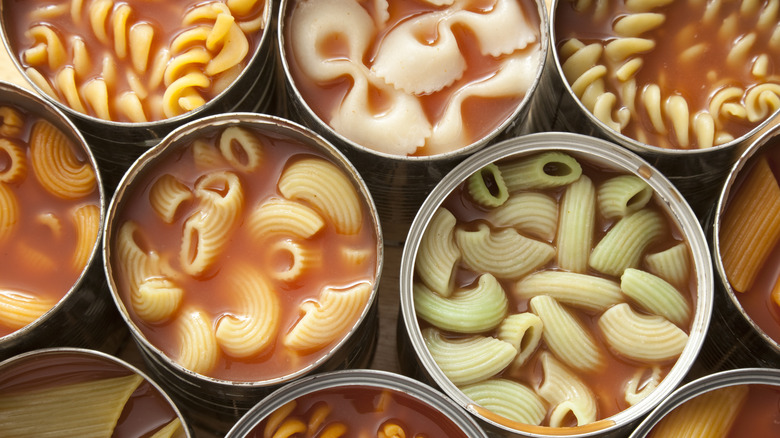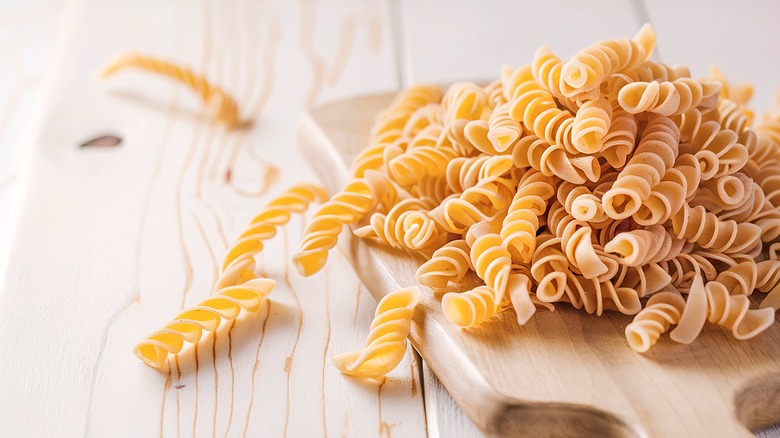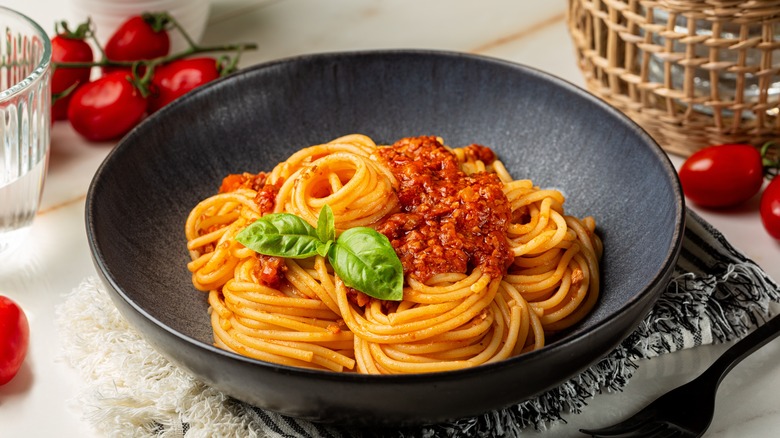Trust Us, It's Just Not Worth Buying Canned Noodles
If you're looking for convenience foods that can be ready in minutes and don't require a lot of cooking, forget about the freezer aisle and head for the canned goods. Canning is an old method of preserving food that was invented back during the time of the Napoleonic wars in the late 1700s, which was way before refrigeration became common in the 1920s and 1930s. Not all canned foods are created equal, however. Some foods just aren't the same after they undergo the high heat process of commercial canning, especially any kind of noodles. In fact, in our opinion, it's really just not worth buying canned noodles at all.
Canned spaghetti, ravioli, and even noodle soups have to undergo a process called pressure canning, which heats foods to at least 240 degrees Fahrenheit for 90 minutes to kill harmful pathogens that can grow inside sealed cans of food. As a result, delicate items like noodles can end up overcooked, wet, and overall unappetizing. Canned noodles might be a great option in a few select situations, but ultimately they don't actually save very much cooking time, and they're not going to save you any money.
Cooking dried pasta only takes a few minutes
The main draw of canned pasta is that it saves time, which we can't deny is true. A can of Campbell's Spaghettios, for example, can be hot and ready in about four minutes if you use the microwave, and about the same time if you heat them up on the stove. The problem is, canned spaghetti kinda tastes like tomato soup and the noodles are fat and mushy from absorbing moisture in the can. Not only that, it really doesn't take much longer to boil dried pasta on the stove. In fact, most long noodle pasta like spaghetti, linguini, and tagliatelle only takes eight to 10 minutes to boil, and angel hair pasta only takes three to five minutes.
So while Chef Boyardee Spaghetti & Meatballs might taste like your childhood, you could actually have fresh boiled, al dente spaghetti on the table with only six extra minutes of cooking time if you made regular dried spaghetti, instead. The only time canned pasta is really a good option are times where you can't use a stove to boil pasta, like camping or in a work break room. Even then, it's still better to make a big batch pasta and sauce to eat ahead of time, because the sauce will reheat the pasta perfectly, especially in the microwave.
You might be thinking, "Well, canned noodles are cheaper." But you'd be wrong again if you worked out the math.
Canned pasta is not a cost savings
A can of store-bought noodles like spaghetti, ravioli, or tortellini can be had for around $1.50 to $2, which doesn't seem like a lot of money. However, a standard-sized can of noodles is about 15 to 22 ounces, or around 2 to 2.5 cups. Each serving is about 1 cup, so you'd need more than one can to feed a family of four — and that's assuming your family sticks to the strict serving size on the can, which, keep in mind, 1 cup visually works out to be about the size of a closed fist. Dinner for four could use as many as three cans of noodles, or about $6.
In comparison, a 16-ounce box of store brand pasta can be had for as little as $1, and an 8-ounce can of tomato sauce for half that. Keep in mind that dried pasta cooks up to about double its size, so a whole box of pasta and two cans of sauce will cost $2 total and can easily feed a family of four, with money leftover for a loaf of Italian bread if we're sticking to the same budget as three cans of noodles.
So if you're looking for an easy noodle-based meal, put canned noodles on the list of foods to avoid, and go for dried pasta, instead. It's cheaper, the texture is better, and you can even store it in the pantry for at least one to two years.


